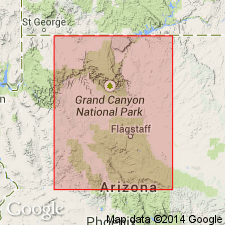
- Usage in publication:
-
- Boucher tongue
- Modifications:
-
- Original reference
- Dominant lithology:
-
- Dolomite
- AAPG geologic province:
-
- Plateau sedimentary province
Summary:
Pg. 14 (fig. 1), 29, 101-102. Boucher tongue of [see below]. Composed of thin beds of rusty-brown dolomite. On fresh surface, dolomite appears steely gray and typically even grained, with crystals averaging 0.25 or 0.30 mm. In places, grades into brownish siltstone. Younger than Parashant tongue (new). [On p. 29 age stated to be Early and Middle Cambrian and on p. 184 (part 2) Middle Cambrian. Age is considered Early and(or) Middle Cambrian.]
Extends southeastward from vicinity of Garnet Canyon at least as far as Cottonwood Canyon, a distance of 25 mi, Grand Canyon area [Coconino Co., northwestern AZ].
_______
GNC note (n.d.): "It is confusing, from McKee's text and fig. 1 whether the tongue is assigned to the Muav formation or to the Bright Angel shale";
US geologic names lexicon (USGS Bull. 1200, p. 438, 1966): Boucher tongue [of Muav formation];
GNU records (USGS DDS-6; Denver GNULEX, 1989, Menlo GNULEX, 1990): Boucher tongue [of Bright Angel shale].
Source: US geologic names lexicon (USGS Bull. 1200, p. 438); supplemental information from GNU records (USGS DDS-6; Menlo GNULEX, Denver GNULEX), GNC index card files.
For more information, please contact Nancy Stamm, Geologic Names Committee Secretary.
Asterisk (*) indicates published by U.S. Geological Survey authors.
"No current usage" (†) implies that a name has been abandoned or has fallen into disuse. Former usage and, if known, replacement name given in parentheses ( ).
Slash (/) indicates name conflicts with nomenclatural guidelines (CSN, 1933; ACSN, 1961, 1970; NACSN, 1983, 2005, 2021). May be explained within brackets ([ ]).

